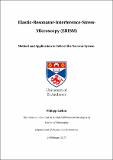Files in this item
Elastic-resonator-interference-stress-microscopy (ERISM)
Item metadata
| dc.contributor.advisor | Gather, M. C. (Malte Christian) | |
| dc.contributor.author | Liehm, Philipp | |
| dc.coverage.spatial | xiii, 180 p. | en_US |
| dc.date.accessioned | 2017-05-23T15:28:07Z | |
| dc.date.available | 2017-05-23T15:28:07Z | |
| dc.date.issued | 2017-06-23 | |
| dc.identifier.uri | https://hdl.handle.net/10023/10824 | |
| dc.description.abstract | The forces biological cells apply to their environment are recognised to be critical during processes like migration, division, wound healing, and stem cell differentiation. Methods to measure these forces have been extremely valuable in contributing to our understanding of cell-substrate and cell-cell interactions. However, existing force sensing techniques struggle to measure forces cells apply perpendicular to the plane of their substrate although these out-of-plane forces have been demonstrated to be important in many processes. In addition, most currently used force sensing techniques require fluorescence imaging which can lead to photo-toxic effects if high frame rates are required. Finally, many methods require detaching of cells after the measurement which prevents measuring the same cells repeatedly or using immunostaining, which is an important tool for linking biomechanical and biochemical observations. In this thesis, we introduce a novel high-throughput and low-light-intensity force sensing technique which is inherently well suited to measure vertical forces. Elastic-Resonator-Interference-Stress-Microscopy (ERISM) measures the spatially resolved reflectance of an elastic micro-cavity. With fully automated hyperspectral imaging and data analysis supported by transfer-matrix modelling, this allows tracking of nanometre thickness changes across a large area of the cavity. By combining Atomic-Force-Microscopy with a Finite-Element-Method, we extract basic material properties of the micro-cavities to calculate stress and force. Using the example of different neural cells, we provide experimental evidence that ERISM measurements can be performed over hours at high frame rates or repeatedly over weeks for the same sample to investigate a variety of cellular processes like cell spreading, growth cone migration, and stem cell differentiation. We perform immunostaining for cell specific markers on ERISM micro-cavities as detaching of the cells is not required. Furthermore, we find that the high throughput of ERISM allows us to find significant differences between wild-type and knock-out cell populations for a gene associated with dyslexia. | en |
| dc.language.iso | en | en_US |
| dc.publisher | University of St Andrews | |
| dc.subject | TFM | en |
| dc.subject | Traction force | en |
| dc.subject | Stem cells | en |
| dc.subject | Force sensing | en |
| dc.subject.lcc | QM451.L54 | |
| dc.title | Elastic-resonator-interference-stress-microscopy (ERISM) | en_US |
| dc.type | Thesis | en_US |
| dc.contributor.sponsor | Engineering and Physical Sciences Research Council (EPSRC) | en_US |
| dc.contributor.sponsor | Scottish Universities Physics Alliance (SUPA) | en_US |
| dc.contributor.sponsor | Human Frontier Science Program (Strasbourg, France) | en_US |
| dc.contributor.sponsor | RS MacDonald Charitable Trust | en_US |
| dc.type.qualificationlevel | Doctoral | en_US |
| dc.type.qualificationname | PhD Doctor of Philosophy | en_US |
| dc.publisher.institution | The University of St Andrews | en_US |
| dc.publisher.department | Physics & Astronomy | en_US |
This item appears in the following Collection(s)
Items in the St Andrews Research Repository are protected by copyright, with all rights reserved, unless otherwise indicated.

